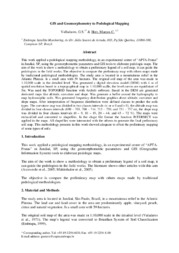Gis and Geomorphometry to Pedological Mapping.
Gis and Geomorphometry to Pedological Mapping.
Author(s): VALLADARES, G. S.; HOTT, M. C.
Summary: This work applied a pedological mapping methodology, in an experimental center of ?APTA-Frutas? in Jundiaí, SP, using the geomorphometric parameters and GIS tools to elaborate pedologic maps. The aim of the work is show a methodology to obtain a preliminary legend of a soil map, it can guide the pedologists in the field works. The objective is compare the preliminary map with others maps made by tradicional pedological methodologies. The study area is located in a mountainous relief in the Atlantic Plateau. Is a small area with 59 hectares. The original soil map of the area was made in 1:10,000 scale in the detailed level. Was generated a digital elevation model (DEM) with 4 m of spatial resolution based in a topographical map in 1:10,000 scalle, the level curves are equidistant of 5m. Was used the TOPOGRID function with ArcInfo software. Based in the DEM are generated derivated maps like altitude, curvature and slope. Was generate a buffer around the hydrography to map hydromophic soils. Was generated frequency distribution graphics about altitude, curvature and slope maps. After interpretation of frequence distribution were defined classes to predict the soils types. The curvature map was divided in two classes intervals (< or = 0 and > 0), the altitude map was divided in four classes intervals (690 ? 703, 704 ? 714, 715 ? 730, and 731 ? 757 m), the slope map was divided in four classes intervals (0 ? 9, 10 ? 19, 20 ? 44, and 45 ? 72 %). The maps were reclassified and converted to shapefiles. In the shape file format the function INTERSECT was applied in the maps. All shapefiles were intersected with the otherrs to generate the final preliminary soil map. This methodology presents in this work showed adequate to effect the preliminary mapping of some types of soils.
Publication year: 2006
Types of publication: Paper in annals and proceedings
Unit: Embrapa Territorial
Keywords: Pedological mapping methodology
Observation
Some of Embrapa's publications are published as ePub files. To read them, use or download one of the following free software options to your computer or mobile device. Android: Google Play Books; IOS: iBooks; Windows and Linux: Calibre.
Access other publications
Access the Agricultural Research Database (BDPA) to consult Embrapa's full library collection and records.
Visit Embrapa Bookstore to purchase books and other publications sold by Embrapa.

